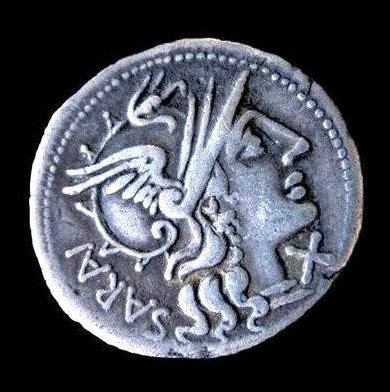
AR denarius, c. 155 - 120 BC, M. Atilius Saranus |

Obv.
Helmeted head of Roma, city goddess of Rome; X below chin, SARAN
behind, circular border of dots. Below her chin is a value mark X, the
Roman numeral for 10 bronze asses. During the Punic wars
this was retariffed to 16 asses and in c. 90 BC replaced with a crossed
X symbol. Behind Roma's head is the abbreviated name (SARAN) of the moneyer, M. Atilius Saranus. Some letters are joined to form ligatures, letters common on Republican coins. The origin of the cognomen Serranus = Saranus is uncertain and only Saranus appears on known coins. Some ancient writers derive the name from the Latin serere - according to which Atilius Regulus, an ancestor of the Serrani, allegedly was sowing when he received the news of his appointment as consul. Another ancient explanation has it that the name is derived from the ancient Umbrian town of Saranum. Both sides of the denarius are surrounded by a beaded border, a characteristic found on most Roman coins for centuries following this early use. Here we still have a public coin with the moneyer displaying his name only. This was to change over time.The head of Roma is engraved in low relief showing up from the fields of the coin enough so that the edge view of the coin shows a 3D effect. Ancient coins vary greatly in terms of relief, but almost all are much higher than modern coins. Note the low relief, the rigid lines of the head, and stiff locks that once fell in waves from her neck as formerly depicted by Greek artists. Portraiture in high relief on denarii experienced a period of revival under Caesar when a number of coins was struck in the East shortly after his victory over Pompey. Rev. Dioscuri on horseback, riding to the right, stars above each head, M. ATIL below. |